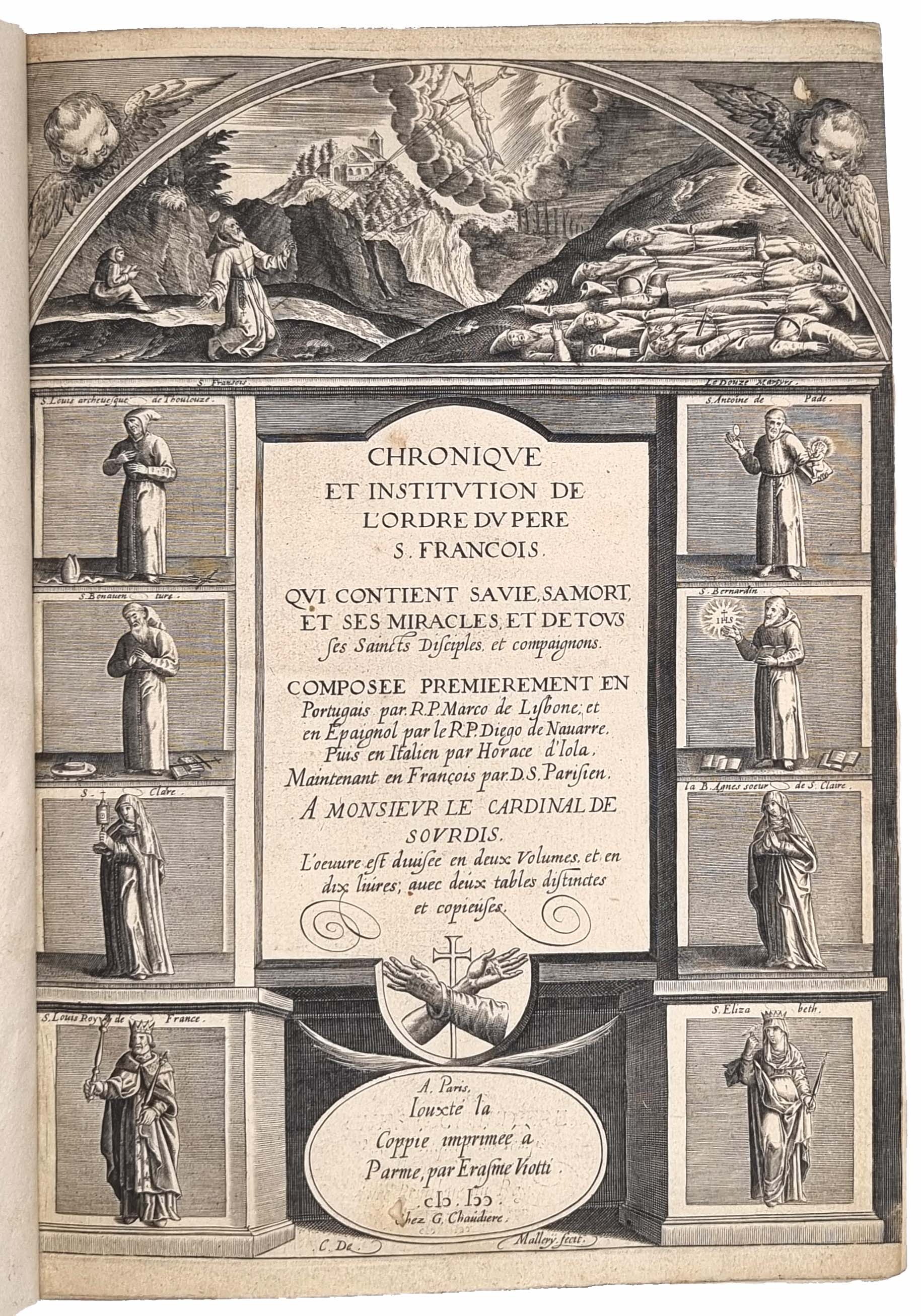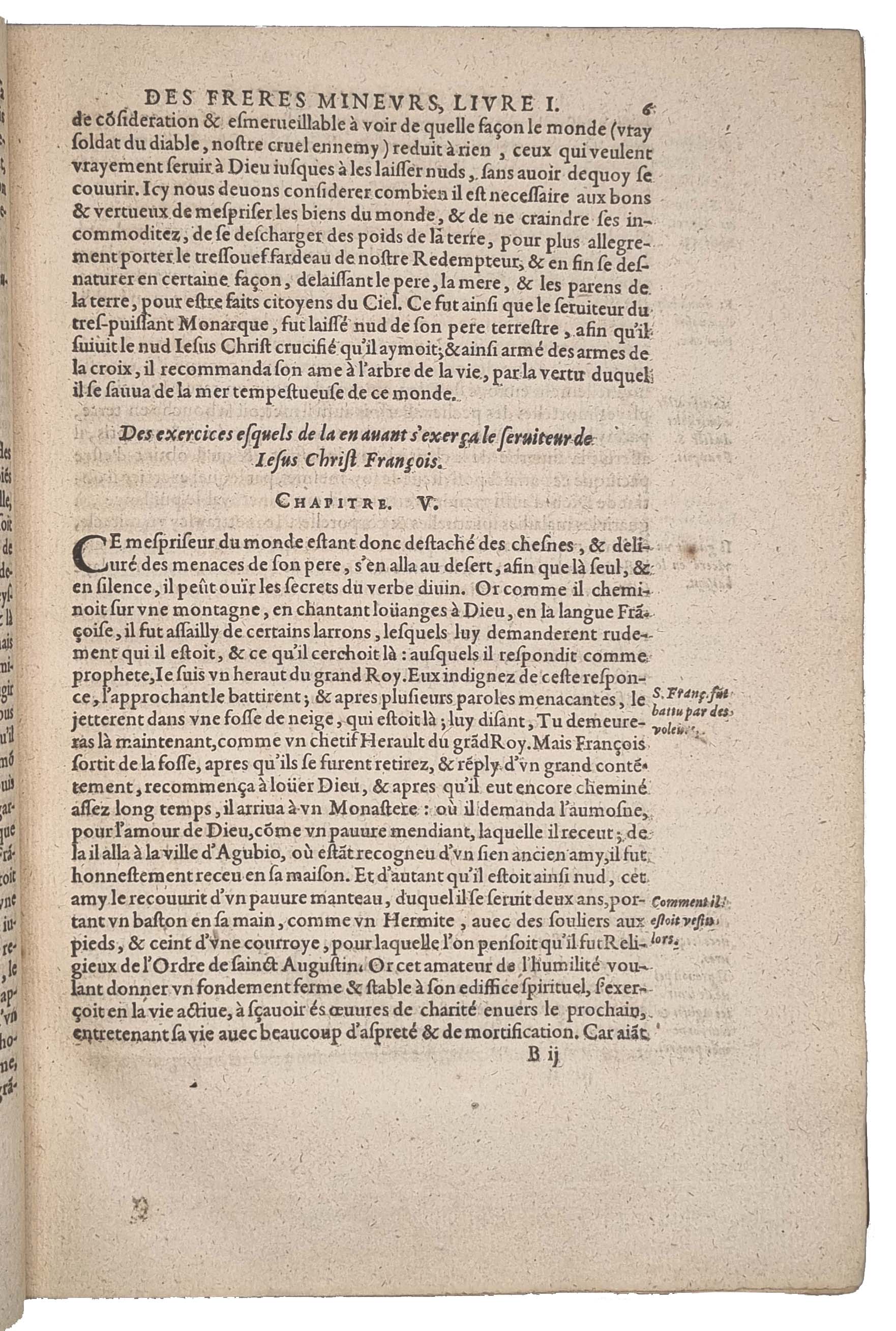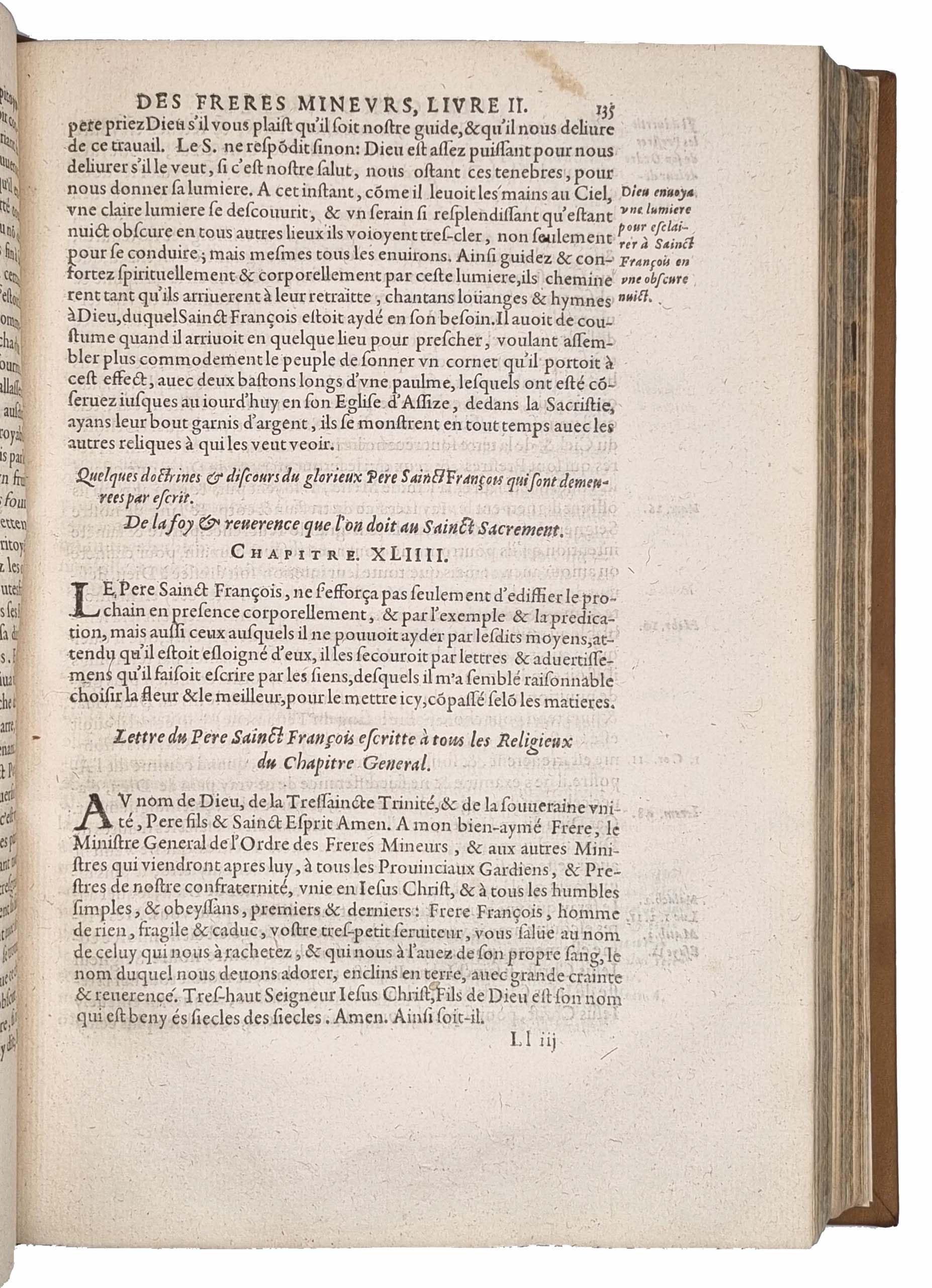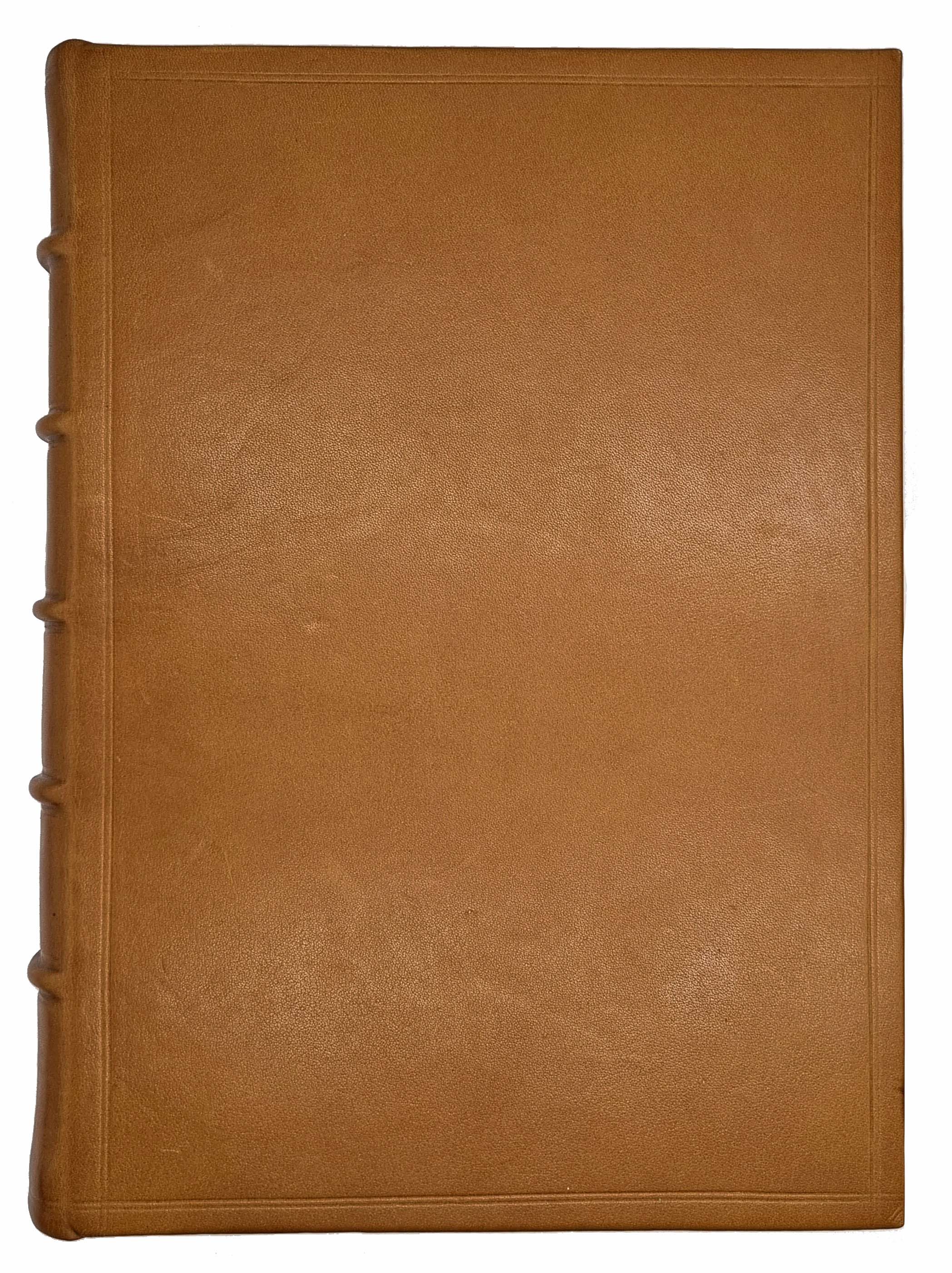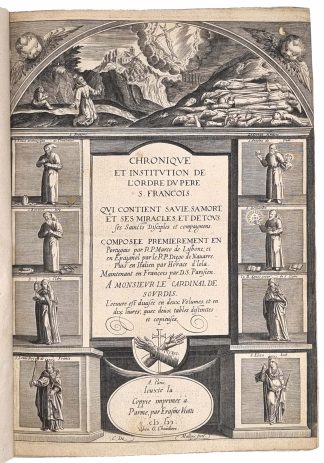MARCOS de Lisboa.
TRAVELS INTO ASIA
Chronique et institution de l᾽ordre du pere S. François.
Paris, chez Guillaume Chaudière, 1600£3,750.00
FIRST EDITION thus. 4to. ff. [xxii] 188 [xi] [x] 189 344:+4, ++4, +++2, ã4,~e4, ~i4, A-Zz4, AAa4, [3*]4, [3]4, (??)3, *4, **6, BBb-ZZz4, AAAa-RRRr4. Roman letter. Fine engraved t-p. St. Francis above with martyrs, portraits of Franciscan Saints at sides, grotesque woodcut initials and headpieces. Light age yellowing, very rare marginal spot. A very good copy, crisp and clean with good margins, in modern tan calf, spine with raised bands, all edges marbled blue.
First edition of the first translation into French, by Diego Navarro, of this important work on the history of the Franciscan Order. Marcos de Lisboa “Friar minor, historian, and Bishop of Oporto in Portugal, b. at Lisbon d. in 1591. While visiting the principal convents of the Franciscan Order in Spain, Italy, and France, at the instance of the minister general, Fr. Andrea Alvarez, he succeeded in collecting a number of original documents bearing upon the history of the order. Previous to this in 1532 the minister general, Father Paul Pisotti, had instructed all the provincials of the order to collect all documents they could find pertaining to the fifteenth century, for the purpose of continuing the “Conformities” of Bartholomew of Pisa. A great part of the material thus brought together was given to Mark of Lisbon; with the aid of which, and of the Chronicle of Marianus of Florence and what he had himself collected, he compiled in Portuguese his well-known “Chronicle of the Friars Minor”, published at Lisbon in 1556-68. This work has gone through several editions; and has been translated into Italian, French, and Spanish, and partly into English. … The work is taken up almost completely with biographies of illustrious men of the order, the title being thus somewhat misleading. It is of great historical value, especially since the original sources to which the author had access, have entirely disappeared. It is worth recording that to Mark of Lisbon we are indebted for the first edition of a grammar of the Bicol language in the Philippine Islands.” Catholic encyclopaedia.
The work is of particular interest now in recording the early missions of the Franciscans in Asia. “But the Jesuits had not been the first missionaries to arrive in East Asia. The Friars Minor had worked in the region since the time of the Mongols. Moreover, the friars had accompanied the first Portuguese voyages along the sea route to India. Erasing them from their rightful place in the first chapters of the story of the spread of Christianity in Asia was justly felt as an affront to Franciscan honour. It is therefore no surprise that early modern Franciscan chroniclers sought to reclaim the memory of their pioneering efforts. .. Those adventures were considered among the many accomplishments of the early friars and thus repeated in institutional histories that circulated among Franciscans. Perhaps the most influential of the chronicles where the story of the early friars in Asia was recounted is the Crónica da Ordem dos Frades Menores (3 vols., 1557-1570), written by Frei Marcos de Lisboa (1511-1591) in Portuguese and widely translated. This massive book included several chapters on the story of the Franciscans who followed the Silk Road to the lands of the Great Khan —understood to be Central Asian territories ruled over by descendants of Genghis Khan (1206-1227), although these places were not precisely situated in medieval or early modern texts. Frei Marcos recounted how Pope Innocent IV (r.1243-1254) sent priests to the “most ferocious and cruel Tartar people, who seemed intent on destroying the whole world.” Summoning friars to act as ambassadors, Innocent sent them on two routes into Asia with news of the gospel, “so that at least the fear of God might curb their many cruelties.” The southern route took one Dominican-led expedition to Persia. The northern expedition, a Franciscan group led by Giovanni da Pian del Carpine (1180-1252), made it to Tartaria in 1245 after suffering great hardships along their route. Having passed through “many labors, dangers, and weakness from hunger, since they ate nothing but wheat boiled in water, and to drink they had to melt water that was frozen over a fire,” they were rewarded with dramatic results. In the succinct résumé of Frei Marcos: “They made great conversions to the faith among the Tartars, and had a custody or vicariate of many convents among the Tartars”.. Frei Marcos’s later chapters mention another set of Franciscan emissaries, one sent by Benedict XII (r.1334-1342) into Tartaria nearly a century later, in 1341. Soon after they arrived at their destination, this group led by Giovanni de’ Marignolli (called João de Florença here) was expelled to lands further east by a Muslim usurper of the Tartar throne —who had, however, first delivered some of the friars to a Muslim crowd that “very cruelly cut them to pieces with swords”. In those more distant Eastern lands, referred to as the “most vast empire of the Great Khan”, Marignolli was received cordially and given a “general license to preach throughout his empire”. Carrying a great cross in his hand, Lisboa reported, “preaching with his friars in all places, he converted many pagans to the faith of Christ, and built many churches, always preaching the name of Christ, without fear”. .. Frei Marcos de Lisboa was able to examine archives of various Franciscan houses in Spain and Portugal, sifting through medieval documents in order to craft his narrative. He learned of the thirteenth and fourteenth century missions out along the Silk Road since reports about them circulated as far as Iberia. Records of the papal pronouncements that spurred these voyages and conceded Franciscans privileges to organize and administer new churches in distant lands were also mentioned in Lisboa’s chronicle.” Liam Matthew Brockey. “Conquests of Memory: Franciscan Chronicles of the East Asian Church in the Early Modern Period”.
A good copy of this important work.
In stock


